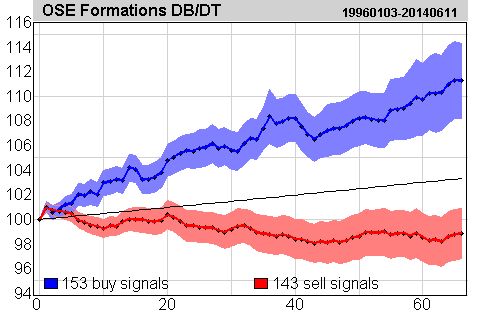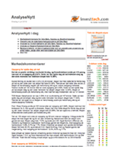Signals from double top and double bottom formations, Oslo Stock Exchange 1996-2014
Research results from Investtech, 6 February 2015
Published in English on 13 February 2015. Norwegian original here >>
Stocks with long term buy signals from double bottom formations rose on average by 11.3 per cent in the following three months. Stocks with sell signals from long term double top formations fell on average by 1.1 per cent the next three months. This is shown in a research report from Investtech based on 19 years of data from the Oslo Stock Exchange.
A double top formation is a top formation which marks the end of a rising period. The formation consists of two tops of approximately the same width and height, see figure 1. The formation of a double top mirrors increasing pessimism among investors and signals the beginning of a falling trend. Double top formations are especially useful in predicting long term market trend reversals, but are also used in the shorter term.
There is an opposite version of this formation; the double bottom formation, see figure 2. This is a bottom formation which marks the end of a falling period. A double bottom formation signals increasing optimism among investors and the start of a rising trend.

Figure 1: Sell signal from double top formation.

Figure 2: Buy signal from double bottom formation.
In technical analysis terminology, a break down from a double top formation triggers a sell signal. Similarly a break upwards from a double bottom formation triggers a buy signal.
Investtech’s Head of Research Mr. Linløkken has studied the price movements that have followed such buy and sell signals on Norway’s Oslo Stock Exchange in a period of 19 years, from 1996 to 2014.
Investtech’s computers identified 153 buy signals and 143 sell signals in this period.
Figure 3: Price development after buy and sell signals from double bottom and double top formations on the Oslo Stock Exchange identified by Investtech’s automatic algorithms in long term price charts. Click the image for bigger version.
The chart shows average price development 66 days after buy signals from double bottom formations and sell signals from double top formations. The signals are triggered on day 0. Only days when the exchange is open are included, so 66 days equal approximately 3 months. Buy signals are the blue line and the sell signals are the red one. The shaded areas show the standard deviation for these calculations. The black line is the benchmark index.
On average, stocks with buy signals rose by 11.3 % in 3 months, whereas stocks with sell signals fell by 1.1 %.
These statistics are based on a relatively small number of data points. The results from the Swedish Stockholm Stock Exchange point in the same direction, but are clearer for sell signals and less clear for buy signals. This shows that further studies are required.
Read the complete research report here for more results and details.
Keywords: Buy signal,Double bottom,Double top,Oslo Stock Exchange,Sell signal,statistics.
Written by

Head of Research and Analysis
at Investtech
Insight & Skills:
Buy signal from double bottom formation
Sell signal from double top formation
Research results:
Return following signals from rectangle formations – the Oslo Stock Exchange 1996-2014
Return following signals from rectangle formations – the Stockholm Stock Exchange 2003-2014
Return following signals from head and shoulders formations - the Oslo Stock Exchange 1996-2014
"Investtech analyses the psychology of the market and gives concrete trading suggestions every day."

Partner & Senior Advisor - Investtech
Investtech guarantees neither the entirety nor accuracy of the analyses. Any consequent exposure related to the advice / signals which emerge in the analyses is completely and entirely at the investors own expense and risk. Investtech is not responsible for any loss, either directly or indirectly, which arises as a result of the use of Investtechs analyses. Details of any arising conflicts of interest will always appear in the investment recommendations. Further information about Investtechs analyses can be found here disclaimer.
The content provided by Investtech.com is NOT SEC or FSA regulated and is therefore not intended for US or UK consumers.
Investtech guarantees neither the entirety nor accuracy of the analyses. Any consequent exposure related to the advice / signals which emerge in the analyses is completely and entirely at the investors own expense and risk. Investtech is not responsible for any loss, either directly or indirectly, which arises as a result of the use of Investtechs analyses. Details of any arising conflicts of interest will always appear in the investment recommendations. Further information about Investtechs analyses can be found here disclaimer.
The content provided by Investtech.com is NOT SEC or FSA regulated and is therefore not intended for US or UK consumers.


 Oslo Børs
Oslo Børs Stockholmsbörsen
Stockholmsbörsen Københavns Fondsbørs
Københavns Fondsbørs Helsingin pörssi
Helsingin pörssi World Indices
World Indices US Stocks
US Stocks Toronto Stock Exchange
Toronto Stock Exchange London Stock Exchange
London Stock Exchange Euronext Amsterdam
Euronext Amsterdam Euronext Brussel
Euronext Brussel DAX
DAX CAC 40
CAC 40 Mumbai S.E.
Mumbai S.E. Commodities
Commodities Currency
Currency Cryptocurrency
Cryptocurrency Exchange Traded Funds
Exchange Traded Funds Investtech Indices
Investtech Indices



